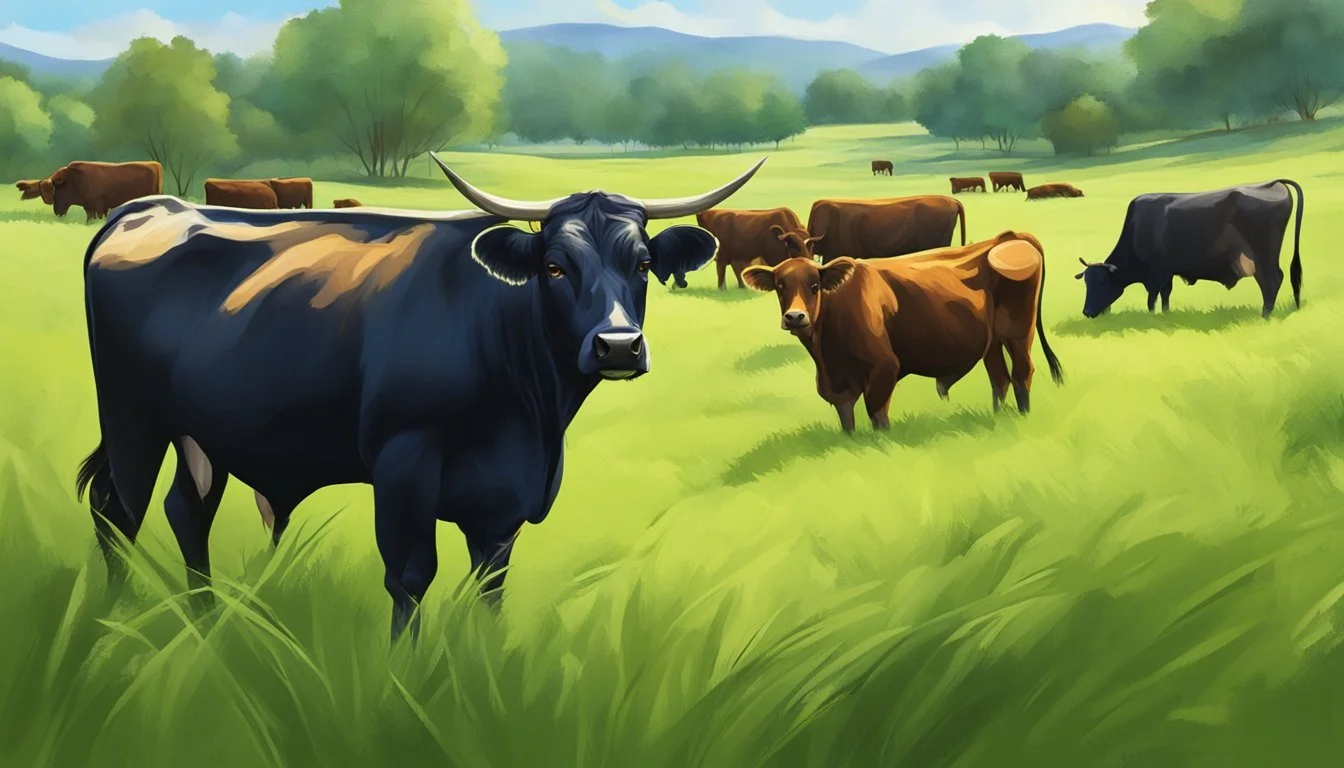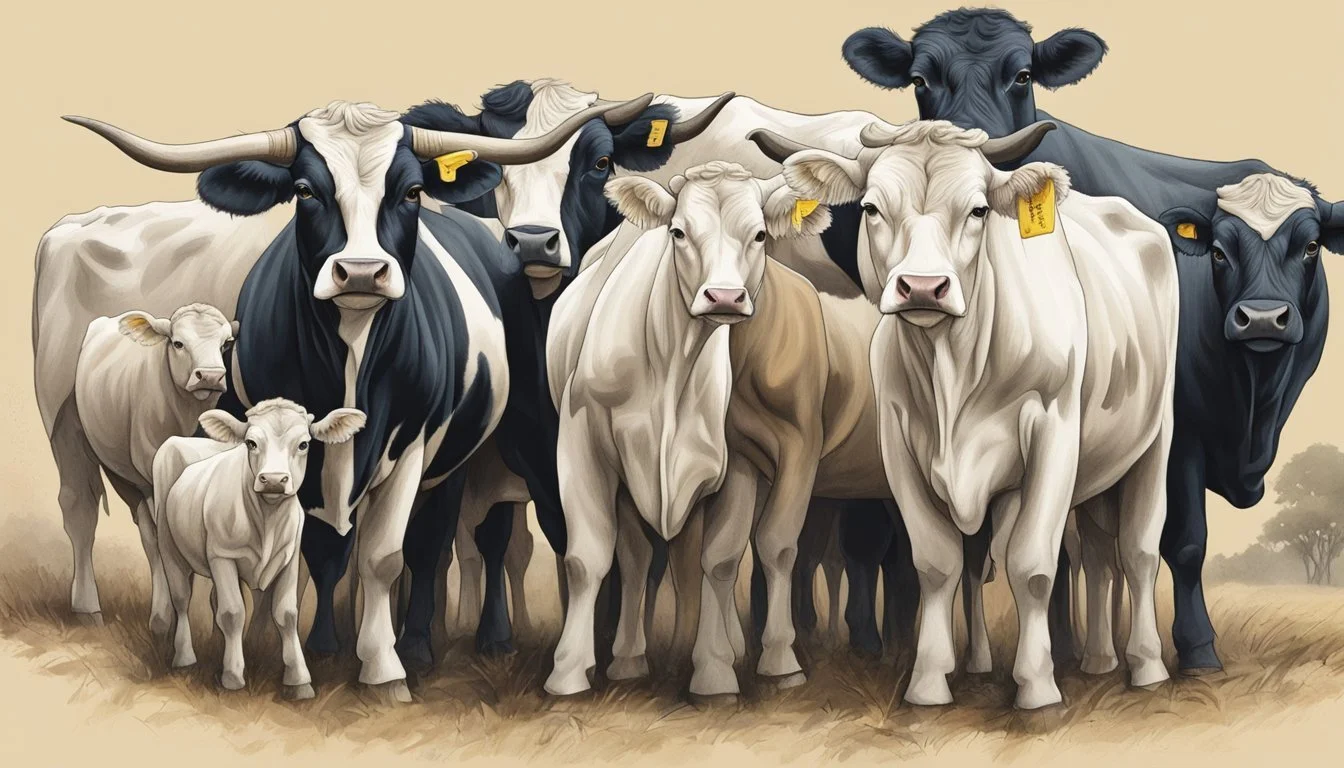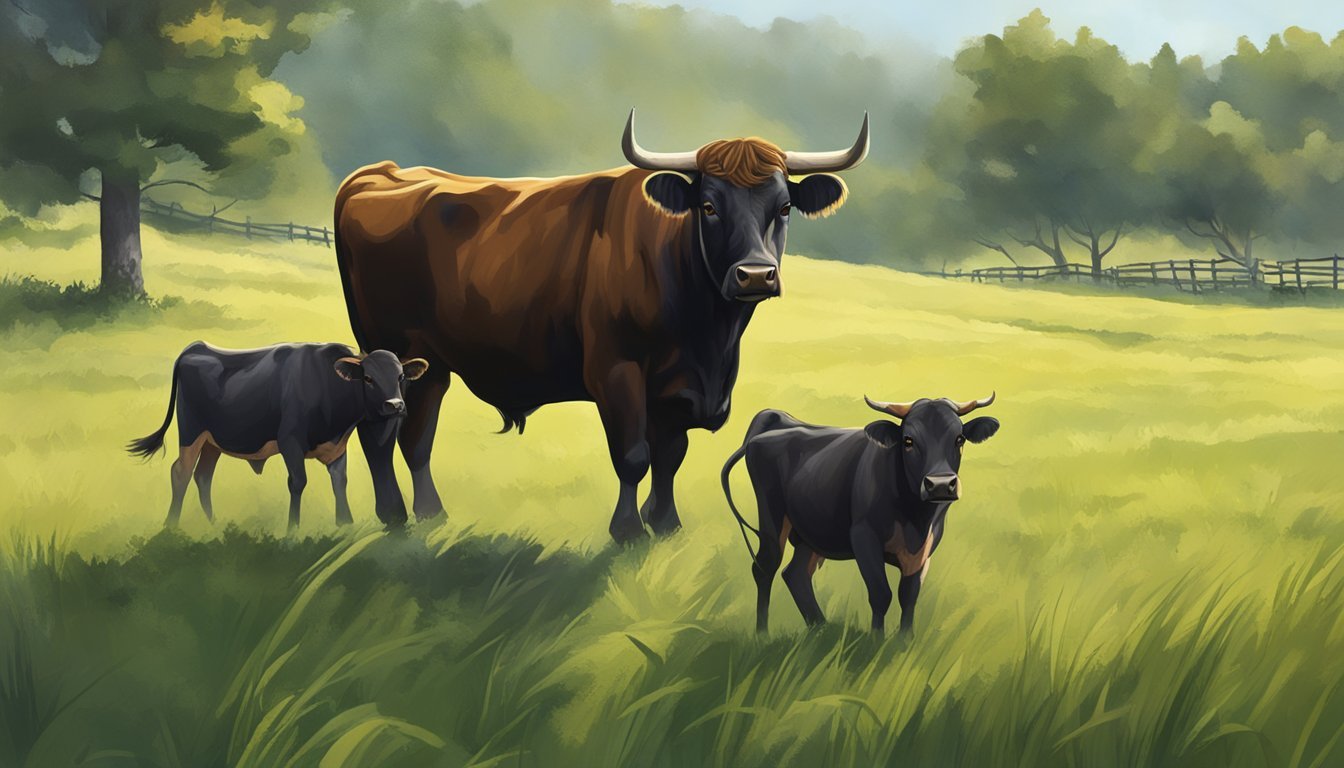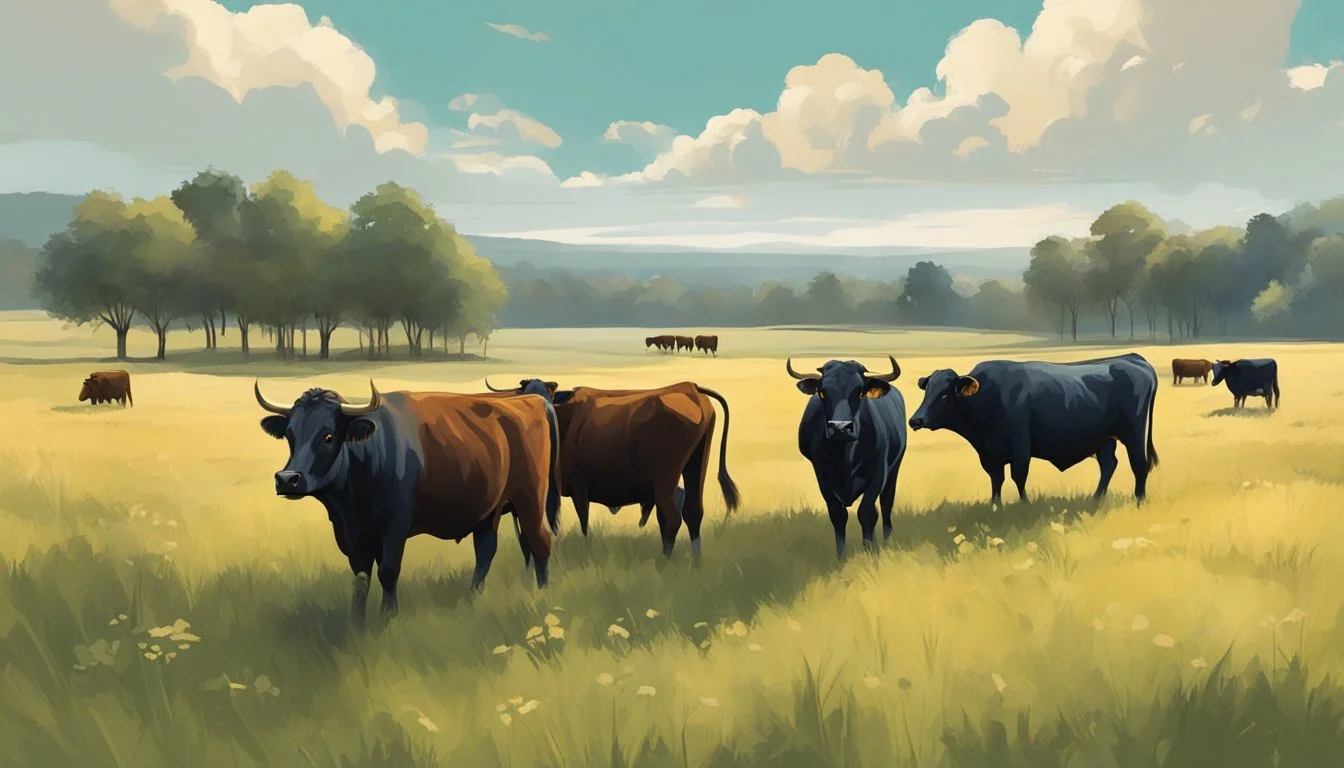Dexter Cattle Social Behavior
Understanding Herd Dynamics for Effective Management
Dexter cattle, originating from Ireland, are a small, sturdy breed known for their dual purpose of milk and meat production, as well as being suitable for smaller farms due to their manageable size. In a herd setting, these cattle display a range of social behaviors that are vital for herd stability and individual well-being. Observing Dexter cattle can provide insightful glimpses into the social structure and dynamics of the herd, where animals establish hierarchies that influence their access to resources such as food and resting spaces.
The social hierarchy in Dexter herds is typically determined by factors like age, sex, and physical strength, with more dominant animals asserting their status over subordinates. This inherent social order influences herd interactions, and managing these interactions is crucial to minimize stress and maintain a peaceful, productive environment. For instance, alterations to the herd such as introducing new cattle or re-grouping can disrupt the established social order, potentially causing stress and conflict that can have detrimental effects on health and productivity.
Effective management of Dexter cattle involves not only an understanding of their social behavior but also the implementation of practices that respect their social structures. Stress reduction, achieved through maintaining consistent social groups and considering family ties, particularly maternal lineage, is important in day-to-day herd management. By providing environments that allow for the natural expression of social behaviors, farmers can foster a stable herd dynamic, which is essential for the overall welfare and productivity of Dexter cattle.
Understanding Dexter Cattle
Dexter cattle are known for their versatility and hardiness, contributing to their growing popularity among small-scale farmers and homesteaders. This section explores the breed's distinctive characteristics and genetic traits that influence their behavior and management within a herd.
Breed Characteristics
Size: Dexters are a smaller-sized breed, which makes them easier to handle than larger dairy or beef breeds. They typically weigh between 600 to 1000 pounds, with cows generally weighing less than bulls.
Color: Common coat colors for Dexter cattle include black, red, and occasionally dun. Their varied coat colors can be attributed to the genetics inherited from their ancestral lines.
Temperament: Dexter cattle are acknowledged for their docile temperament. This affability makes them well-suited for farmers who handle their livestock directly. The gentle nature of Dexters also contributes to a stable social structure within the herd.
Horns: Dexters naturally grow horns, but they can also be polled (hornless). Whether or not they have horns may influence their position within the herd's social hierarchy.
Genetic Traits
Dairy Traits: Dexter cows are dual-purpose animals, valued for both milk and beef production. Their milk has a higher butterfat content compared to other dairy cattle, which is suitable for cheese-making and other dairy products.
Beef Traits: Despite their size, Dexter cattle have a good meat-to-bone ratio, producing a high yield of quality beef. The breed's hardiness contributes to its ability to thrive in various climates, impacting the overall health and meat quality.
Genetic Variation and Correlations: There is a notable genetic variation within the breed that affects characteristics such as size, color, and milking ability. Researchers have noted genetic correlations between traits, such as the relationship between body size and milk yield, that are important for breeders to consider when managing and selecting animals for reproduction.
Social Structure and Hierarchy
Dexter cattle, like other bovine species, exhibit complex social behaviors that include the formation of distinct groups and a clear pecking order. Managing these behaviors is vital for herd welfare and stability.
Formation of Social Groups
In Dexter herds, social groups typically consist of cows (adult females), their offspring (calves), and heifers (young females), which form close-knit clusters known as matrilineal family groups. Bulls (adult males) may either lead a small number of cows or exist on the fringes of these female-led groups. The social structure of the herd influences day-to-day activities like grazing, resting, and movement through pasture, reinforcing social bonds.
Mothers and calves: Strong affiliative bonds.
Heifers: Often integrate into the mother's group.
Bulls: Maintain a more solitary presence or form bachelor groups.
Dominance and Leadership
Leadership in a Dexter herd is typically determined by age, size, and personality, leading to a clearly defined social hierarchy.
Dominant individuals: influence herd movement, have priority access to resources, and lead during potentially threatening situations.
Subordinate cattle: follow cues from the leaders, often waiting their turn for feeding or water.
Agonistic interactions play a crucial role in establishing and maintaining the social order. These interactions are more common:
During initial group formation or introduction of new members.
Among bulls during the breeding season, as they compete for mating opportunities.
Social dominance can be fluid among heifers and cows:
Heifers may rise in rank as they mature and successfully calve.
Shifts in dominance can occur without aggressive encounters, based merely on changes in age or physical condition.
Understanding the social dynamics within Dexter cattle helps manage the herd more efficiently, ensuring both animal welfare and productivity.
Social Interactions in Dexter Cattle
Dexter cattle, like other bovines, exhibit a range of social behaviors that facilitate herd cohesion and establish social hierarchies. Understanding these interactions is crucial for effective herd management and welfare.
Positive Interactions
Social grooming plays an integral role in the social life of Dexter cattle. Allogrooming, which includes behaviors such as licking and nuzzling, serves as an affiliative behavior that strengthens social bonds within the herd. Social facilitation, where cattle mimic the behaviors of others in the herd, often leads to collective behaviors like grazing and resting, promoting group cohesion. Dexter cattle also engage in social learning, where younger or less experienced members observe and imitate the behaviors of more seasoned individuals—further reinforcing the herd's social structure.
Agonistic Behaviors
Agonistic behaviors among Dexter cattle are important for maintaining social order and determining rank within the herd. Instances of aggression, including headbutts and pushing, are typically observed during disputes over resources or social standing. While these agonistic behaviors can lead to social stress, an understanding of these interactions helps in managing the herd to minimize conflicts and ensure the welfare of all individuals.
Communication and Behavioral Signals
Dexter cattle utilize a rich repertoire of vocal and non-vocal cues to convey a wide range of emotions, intentions, and information. Their communication is integral for maintaining herd dynamics and individual relationships.
Vocal and Non-vocal Cues
Dexter cattle employ a variety of vocalizations to communicate. The most recognizable is the "moo," which serves multiple purposes. A moo can signify an attempt to locate other herd members, often used by a cow to find her calf. It also can indicate stress or discomfort due to factors such as changes in the environment or health issues. Aside from mooing, other vocal cues like snorts or bellowing might indicate agitation or a warning to others.
Non-vocal cues are equally important and often involve olfactory signals. Cattle frequently engage in sniffing as a greeting or to gain information about the reproductive status of a herd mate. Scents can convey a range of data, from identifying individual members to detecting pheromones during estrous cycles.
Body Language and Physical Contact
Body language serves as a key indicator of mood and intent in Dexter cattle. Displays of dominance might involve a lowered head, direct stares, or even headbutts, while submissive cattle often avoid eye contact and keep their heads down. Play behavior is characterized by more open, fluid movements and is essential in young Dexter cattle for learning social norms and developing relationships.
Physical contact, such as licking and the hip nudge, usually signifies forms of social bonding and grooming, which can alleviate stress and strengthen social connections. Licking is particularly common between mothers and calves, as well as among peers. In contrast, more abrupt contact such as pushes or shoves can be distress signals or attempts to reinforce hierarchical structures within the herd. Understanding these behaviors is crucial for effective herd management and ensuring the well-being of Dexter cattle.
Reproductive Behavior and Calving
Dexter cattle exhibit specific patterns during their reproductive cycles that influence herd dynamics. Understanding these behaviors is crucial for effective herd management, particularly during breeding and calving seasons.
Breeding Season Dynamics
During the breeding season, Dexter bulls become more active as they seek mating opportunities with cows. The cows experience estrous cycles, typically with a heat period that lasts about 18 hours. During this time, cows may show signs of restlessness, reduced food intake, and increased movement. Bulls, detecting these signals, compete for access to receptive females. Strong social relationships can influence mating opportunities, as cows may exhibit preferential behavior towards certain bulls.
Calving usually takes place after a gestation period of approximately nine months. As parturition approaches, pregnant Dexter cows often become more isolated, seeking quiet and safe places to give birth. Herd managers should monitor for signs of imminent calving, such as the cow's restlessness and her udder filling with milk.
Mother-Calf Bonding
Post-calving, Dexter cattle display strong maternal behaviors. Mothers are protective and form immediate bonds with their calves, demonstrating affiliative behaviors such as licking and nuzzling to clean and stimulate the newborn. These actions are essential for calf health and survival, as they not only strengthen the bond but also encourage the calf's first stand and suckle.
The mother-calf connection is a critical aspect of cattle social structure. Calves usually stay with their mothers for several months, during which time they are nurtured and protected. This bond impacts future social relationships within the herd, as maternal care establishes a foundation for social integration and learning behaviors from other herd members. Managers should be aware of these bonds and consider them when making decisions about herd composition to minimize stress on both cows and calves.
Impact of Herd Management
Effective herd management practices are fundamental in shaping the well-being and productivity of Dexter cattle. Strategic interventions in feeding, nutrition, health, and welfare can significantly influence animal behavior and contribute to the overall success of the herd.
Feeding and Nutrition
Dexter cattle, like all livestock, require a diet that fulfills their nutritional requirements to maintain optimal health and productivity. Management practices that ensure a balanced intake of proteins, carbohydrates, fats, vitamins, and minerals are critical for sustaining daily livestock functions and milk production.
Feeding Practices:
Assess individual and group nutritional needs
Provide high-quality forage and supplementary feed
Monitor body condition and adjust diets accordingly
Implementing regimented feeding schedules aligns with the natural feeding behavior of Dexter cattle, thereby reducing competition and stress within the herd. It is also critical to provide sufficient space at feeding stations to prevent dominant individuals from monopolizing resources, which can adversely affect the welfare and milk yield of more submissive animals.
Herd Health and Welfare
A comprehensive herd management strategy encompasses not only the physical health of Dexter cattle but also their mental well-being. Animal welfare is closely linked to productive efficiency and the health status of the herd.
Health Management Tactics:
Regular Health Checks: Timely identification and treatment of diseases.
Vaccination Programs: Prevent outbreaks and protect herd immunity.
Parasite Control: Routine deworming and external parasite management.
Stress management is a significant aspect of health and welfare. Stress in cattle can lead to a suppressed immune system, making them more susceptible to diseases. Therefore, maintaining a stable social structure and minimizing disturbances in the herd are key aspects of reducing stress. Furthermore, designating areas for rest, providing clean water, and enabling access to shelter from environmental extremes contribute to the welfare of the herd.
Overall, Dexter herd management requires a thorough understanding of animal behavior and a commitment to meeting the herd's needs to ensure a well-adjusted, healthy, and productive group of cattle.
Behavioral Adaptations
Dexter cattle, like other breeds, exhibit various behavioral adaptations that enable them to manage stress and cope with environmental and social changes. These adaptations are crucial for their well-being, particularly when subjected to herd management practices.
Stress and Coping Mechanisms
Dexter cattle experience stress in various circumstances, which can be caused by both environmental factors and herd dynamics. Their coping mechanisms are shaped by individual personality traits and can manifest through physical and social behavior. Some cattle may adapt a 'flight' response to stress, displaying heightened fearfulness and a tendency to withdraw from the herd. Others may demonstrate a more aggressive stance, competing for resources to maintain their status within the social hierarchy.
Coping Style: This can range from passive (avoidance behavior, low aggression) to active (seeking social bonds, high aggression).
Social Buffering: In response to distressing situations, cattle often engage in affiliative behaviors, such as grooming, which helps to reduce stress levels within the group.
Stress Indicators: Signs of stress in Dexter cattle include changes in vocalization, altered eating patterns, and increased vigilance or movement.
Environmental and Social Changes
The transition period during regrouping or changes in environment presents significant challenges to Dexter cattle. Adaptation during these times is critical to prevent long-term distress.
Regrouping: This involves the introduction of new members to the herd or the reorganization of existing groups, which often leads to temporary instability and increased competition for resources until a new hierarchy is established.
Transition Period: Adaptation during this period may involve seeking out familiar individuals or establishing new relationships to navigate the altered social landscape.
Environmental Adaptations:
Changes: New Enclosures
Behavior Observed: Exploration mixed with cautious behaviors
Changes: Change in Routine
Behavior Observed: Initial resistance followed by gradual acceptance
These behavioral adaptations highlight the importance of considering individual personalities and stress responses when managing Dexter cattle. Through understanding Dexter cattle's coping styles and their responses to social and environmental changes, handlers can tailor management practices to support the health and welfare of each individual within the herd. It underscores the complexity of their behavior and the significance of humane and informed handling practices.
Social Learning and Development
Dexter cattle, despite their smaller stature, exhibit complex social learning behaviors that are crucial for herd integration and individual development. These behaviors are particularly evident during the growth stages of calves and the social integration of youngstock, where observational learning and imitation play key roles.
Learning from the Herd
Young Dexter calves learn from observing the actions and reactions of older herd members, a process known as observational learning. This begins with simple tasks such as following the mother to more complex behaviors including foraging techniques and social cues. For example:
Imitation of Grazing Patterns: Calves observe and mimic the grazing patterns of the herd, learning which plants are food and which areas of the pasture are optimal for feeding.
Social Interactions: By watching interactions within the herd, calves understand the hierarchical structures and learn appropriate social behaviors to avoid conflicts.
As calves grow and integrate into the herd, they refine these behaviors through continuous interaction with cows, heifers, and males.
Development of Youngstock
The development phase from calf to heifer is a critical period for Dexter cattle, marked by key milestones such as weaning and the transition to independent foraging.
Weaning Process:
Age of Transition: Typically occurs between 3 to 6 months when calves gradually shift from a milk-based diet to solid foods.
Independence: Calves develop independence through weaning, which involves a gradual reduction of maternal dependency and an increased reliance on herd dynamics.
During growth stages, youngstock also develop their place within the herd's social structure. It's at this time when:
Heifers and Young Males: Establish their status within the herd, using learned behaviors to navigate social hierarchies without direct maternal support.
Social Bonds: They form social bonds that will influence their behaviors and status as mature Dexter cattle.
The development of these social and self-reliant behaviors in Dexter cattle's formative years lays the groundwork for a well-integrated herd and individual success.
Advanced Topics in Cattle Social Dynamics
A nuanced perspective of cattle social dynamics goes beyond observational studies; it encompasses a data-driven approach to understanding complex social structures and behaviors within bovine communities.
Social Network Analysis
Social Network Analysis (SNA) is a powerful tool for elucidating intricate social structures within Dexter cattle herds. SNA allows researchers to map and measure social networks and preferential relationships, providing insights into the social rank and group cohesion that are not apparent through simple observation. Applying SNA to cattle herds reveals:
Key Individuals: Cattle that act as central figures in the network due to their high connectivity.
Group Level Dynamics: Patterns of association that may indicate sub-group formations within larger herds.
Temporal Aspects: How social connections change over time, important for understanding long-term social stability.
The complexity of these networks can be compared with other social animals such as pigs, sheep, and even non-mammalian species like fish, revealing broad patterns of sociality across animal groups.
Comparative Behavior Studies
Comparative behavior studies enhance understanding by contrasting the social behavior of Dexter cattle with that of other domestic animals like horses, sheep, and pigs. Such comparisons have uncovered that, while there are commonalities such as the establishment of social hierarchies and the formation of close affiliations within groups, the specific social behaviors and the intensity of these relationships can vary significantly:
Hierarchy and Rank: Horses, for instance, often have a linear hierarchy, while cattle may exhibit a more complex structure.
Affiliation Patterns: Sheep may form strong pair bonds not typically seen in cattle.
These differences emphasize the importance of species-specific management practices to promote harmonious herd dynamics and well-being.






